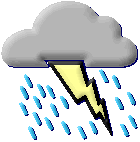|
 Weather
is the state of the atmosphere at a particular place at a specific time
or over a short time. It varies in different places because of different
conditions in the atmosphere. It is described in terms of the atmospheric
elements, such as temperature, humidity,
precipitation, winds
& pressure and clouds. Weather
is the state of the atmosphere at a particular place at a specific time
or over a short time. It varies in different places because of different
conditions in the atmosphere. It is described in terms of the atmospheric
elements, such as temperature, humidity,
precipitation, winds
& pressure and clouds.
Temperature
Temperature is the degree of heat or cold in the atmosphere. It is
measured in °C or °F. All weather systems have well-defined cycles
and structural features and are governed by the laws of heat and motion.
These conditions are studied in meteorology, the science of weather and
weather forecasting.
There are a few factors that affect temperature. And these are :
- Latitude
- Altitude
- Distance from sea
- Ocean currents
- Aspect
- Humidity and cloud cover
- Land surface
Humidity
Humidity is the state of the atmosphere with respect to its water
vapour content. This water vapour comes from the evaporation of water
from ponds, lakes, rivers, seas and oceans ad water that has landed on
any other surfaces such as leaves and branches.
The amount of water vapour the air can hold depends
on its temperature. When the air becomes warmer, it expands and its capacity
to hold water rises. Thus warm air can hold more water vapour than cold
air. The air is saturated when it contains all the water vapour it is
able to hold at a particular temperature. Air is unsaturated when the
amount of water vapour it is holding is less than the maximum amount it
can hold at a particular temperature.
The temperature at which saturation of air occurs
is called dew point.
 Precipitation Precipitation
When cloud particles become too heavy to remain suspended in the air,
they fall to the earth as precipitation. Precipitation occurs in a variety
of forms; hail, rain, freezing rain, sleet or snow.
Formation of precipitation
The air rises or lifted up. This can
occur when a mass of light warm air rises over a mass of heavy cold air,
the onshore wind blows up the windward slope of a highland or heated air
rises in a convection current. After that, the air that has risen or has
been lifted up cools. The cool air becomes saturated at dew point and
on being cooled further as it continues to rise, it condenses into water
droplets around atmospheric particles. Next, the water droplets coalesce
to form clouds. And when the water droplets in the clouds are too heavy
to be suspended in the air, precipitation occurs.
|
Types of Rainfall
|
Convectional Rain
|
Relief Rain
(Orographic rain)
|
Frontal Rain
|
|
Process of Rainfall
|
On a hot day, the air in
contact with the warm ground is heated by conduction. The warm air,
which expands and becomes lighter than the surrounding air, which
can hold a lot of moisture, rieses in a convection current. Normal
rain forming process occurs, resulting in towering cumulonimbus clouds |
Relief rain is formed when
moist onshore air is forced to ascend the windward slope of a mountain.
The rising air expands and cools. Normal rain forming process occurs.
When the water droplets in the clous are too heavy, relief rain falls
on the windward slope. |
Frontal rain is caused by cyclonic
activity, which is formed when two air masses of different temperature,
humidity and density meet. A zone (front) separates these two air
masses. There are two front - warm front and cold front. At the
warm front, the lighter warm air rises gently over the heavier cold
air. At the cold front, the heavy cold air slips under the lighter
warm air and forces it up agressively.
|
|
Weather it brings
|
Not lasting Thunderstorm |
Normal raining on windward
side of the mountain but little or no rain on the leeward side (rainshadow). |
warm front - Light rain falls
steadily over a wide area for several hours
cold front - heavy rain that falls over a small area for a short duration. |
|
Elements present in order to
happens
|
High temeperature and high
humidity, such as tropical areas and during summer in temperate areas.
Usually falls in afternoon. |
Mountains
|
Formed when two air masses
of different temperature, humidity and density meet. |


Winds & Pressure
Wind is the
movement of air between high and low pressure areas. The greater
the difference in pressure, the faster the air moves and the greater the
wind speed.
Air pressure is the weight of the air exerted on any exposed surface.
Air pressure decreases with increasing heights, due to less overlying
air nearer the top of the atmosphere. On the contrary, the air nearest
the ground has the highest pressure because of the weight of overlying
air.
Air pressure varies with temperature. Warm air expands, becomes less
dense and rises, resulting in low pressure. Cold air, whish is denser,
sinks and exerts high pressure.
|
